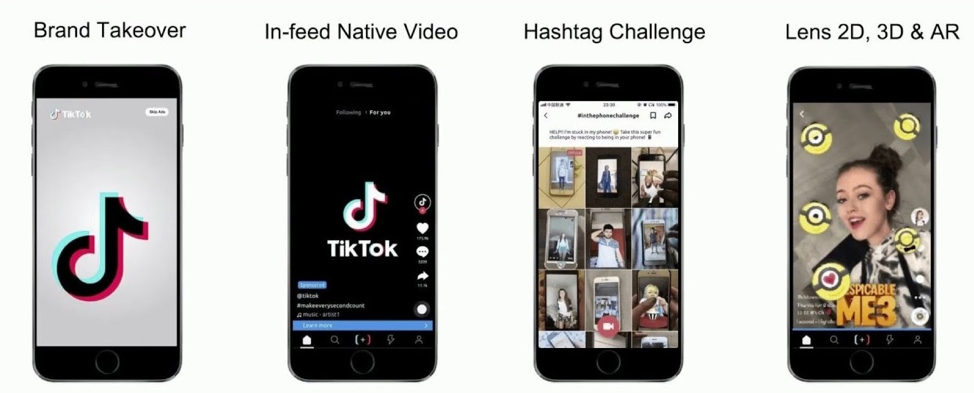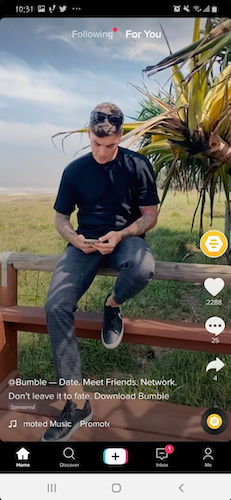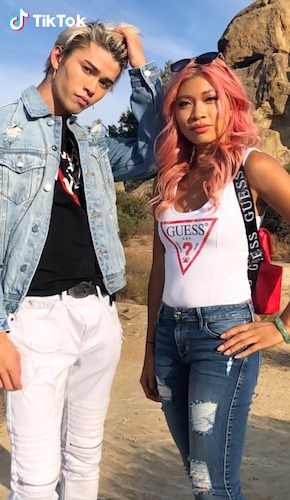Unless you’re spending your life completely unplugged from technology, chances are you’ve seen or heard about the up-and-coming social media platform, TikTok.
Since its release in 2016, the app has quickly catapulted itself to the top, ranking 9th in popularity among social sites. In 2019 alone, the app accumulated upwards of 1.5 billion downloads on the AppStore and Google Play. But where did this boom of interest come from? To truly understand why TikTok is popular, first, we’ve got to take a closer look at the basics.
Becoming A Legend
TikTok is the result of the acquisition of the app Musical.ly by the Beijing-based media and tech company, ByteDance. At the time, ByteDance already had an app that was widely popular, with over 500 million active users in Asia, called TikTok. In a push towards efficiency and global connectivity, the two apps merged into one under the single, more popular name, TikTok.
OK… but what exactly is it?
TikTok is a social media app that allows users to create, view, and share short videos that are set to music or other custom-made sounds/soundtracks. Not just great for content consumption–as TikTok offers endless scrolling and a For You page full of content curated for your view pleasure–TikTok has also made it extremely easy and intuitive for creators to make and share their content.
TikTok is basically a one-stop-shop for creators as it offers a variety of filters, lenses, soundtracks, recording and editing options all within the app itself. While also making it incredibly easy to collaborate and reach other creators around the world.
While its parent app Musical.ly was heavily focused on lip-sync videos, the content on TikTok varies greatly. Some popular types of videos include challenges, pranks, and dancing videos. However, not all users are creating and publishing content. In fact, 68 percent of TikTok users watch someone else’s video and 55 percent upload their own videos (Globalwebindex, 2019), meaning that the majority of users are “watchers” as opposed to “creators”.
…TBH, in many ways, it mirrors the wildly popular app Vine, which was shut down by Twitter in 2014 (RIP).
And, who exactly is using this platform?
Well, TikTok is generally swarming with creators and viewers of a fairly young age. They’re mostly all under 30, and a massive 60 percent of users are said to be between the ages of 16 and 24. This makes TikTok a very strategic platform for advertising or using your business. Though this audience is still quite young, brands must not underestimate the purchasing power and influence of this younger audience.
If you’re looking to reach new and unique audiences, or keep your brand looking hip with the kids, then the answer to one of those questions is: Yes, it’s probably worth it for your brand to create a TikTok profile and make custom videos.
With the potential to reach a younger audience across the globe, a number of well-known celebrities, as well as influencers from other platforms, have jumped aboard the TikTok ship. I mean, almost everyone is doing it! Some of the famous faces you can follow on the app include Cardi B, Lizzo, Howie Mandel, Ariana Grande, BTS, and James Charles just to name a few. With the past success of influencer marketers, the platform has created another place for promotional messages.
Marketing Your Brand on TikTok Organically
Whether you’re ready to start paid advertising on TikTok or not, your brand still needs a relevant and clever way to make an impact on this platform. With the majority of the audience on this app having been raised by the internet, they’re wise to advertiser’s tactics, though that doesn’t necessarily mean they’re opposed to advertising – it just needs to fit in. And what’s the best way to do that on TikTok? Make use of its many unique features, of course!
Here are a few ways to help boost your brand on TikTok:
What’s Trending: If you weren’t aware yet, TikTok basically thrives on trends and memes. If you’re not keeping up with the rapidly changing trends and challenges hitting your “For You” feed weekly (sometimes daily), then you’re falling behind.To best utilize TikTok for your brand, jump on trends and jump on them ASAP!
Organic Hashtag Challenges: An organic hashtag challenge can be created by anyone and it’s free! For this tactic, a user sets a specific task and pairs it with a hashtag. Other TikTok users are then encouraged to try it for themselves and post the result using the associated hashtag. There are also branded Hashtag Challenges that we’ll get into a little later.
Creating and Reusing Sounds: This is where the Musical.ly side of things comes in, as a HUGE part of TikTok is the use of “sounds” to accompany videos. Users are encouraged to create “soundtracks” on TikTok, which can consist of snippets of songs, speeches, TV or movie dialogue, or random user commentary.
The best part is that once you’ve created a sound, it’s saved to TikTok and can be reused by other creators. Having a sound go viral has actually helped to launch certain celebrities’ careers.
Remember “Old Town Road” by Lil Nax X? Yeah, that was thanks to TikTok. It even charted at number one on the Billboard Hot 100 for 19 weeks – the longest in history.
Dance Challenges: With the popularity of sound and music on TikTok, this type of content kind of goes without saying. These challenges spark when one creator dances to a specific song and other users recreate it. Take The Git Up challenge, for example, where users danced a specific routine to Blanco Brown’s song. #DontLetThisFlop
Duets and Effects: TikTok has an unmatched variety of filters and lenses that creators can use in their videos, and one of the most popular styles for this is Duets, which allows users to take another user’s TikTok video, split the screen in half and “interact” or react with the original video. It’s a great way to meet and collaborate with fellow TikTokers and often gain quite a bit of exposure and engagement.TikTok updates its filters often, so remember to keep your eyes open often for your next creation opportunity.
Advertising
Advertising probably seems like an obvious answer when trying to make your big break on TikTok, but considering this platform is still so new, the option to advertise is quite limited and mainly to certain companies or brands, like Maybelline and Warner Bros.
Brands looking into advertising on the platform in the future must be mindful that authentic, even candid, content performs considerably better on the app. With this in mind, figuring out a way to align TikTok’s humorous nature with consistent, natural brand messaging will prove challenging for digital marketers.
Also, knowing that the TikTok audience is largely teens and young adults, brands must be sure that this is the demographic they wish to target. Brands could certainly find success in this channel if they are willing to be creative and think outside of the box in the way of video marketing.
As advertising on TikTok is still in BETA, if you want to advertise on TikTok you’ll need to submit a request to them first where they will determine if your brand, company, or agency is the right fit for them at this time. If you meet the criteria here’s a little more information on what to expect. Paid TikTok ads can come in several forms, including:
In-Feed Native Ads
This is the most affordable option for brands as it is more like any other social media self-serve platform. Unlike other social media platforms, however, TikTok doesn’t have as many ad types yet, their two main options being: Pre-roll ads (videos that start as soon as users open the app) and in-feed ads, videos that appear as users scroll.
Videos on TikTok last up to 15seconds which means your In-Feed Native Video ads must be between 9-15 seconds long. Much like Instagram Stories, this ad type is full-screen and skippable but supports many objectives, like app downloads and website clicks.
For targeting, TikTok offers age, gender, and state-level geo-targeting but that’s about it for now, though the company has promised that they’ll eventually open targeting up to interest, behavioural, and more granular demographic targeting. Luckily, you can create custom audiences–like CRM lists–and to improve brand safety, you can even whitelist or blacklist audiences at this time.
As mentioned before, this is the most affordable option for brands as there is currently no official minimum spend requirement, but TikTok does also have three other ad types that require much larger budgets. For these campaigns, rather than letting you build-and-launch them yourself TikTok will assign you a rep. to help.
Brand Takeover
This ad type makes sure your brand is one of the first things a user sees when they open TikTok, expanding your entire phone screen this option makes your brand message front and centre.
Brand Takeover ads consist of still images, GIFs and videos and can link back to a brand’s landing page or Hashtag Challenge within TikTok. As a heads up, these takeovers are exclusive to categories and only one brand can take over a single category each day… For example, food delivery service Grubhub tried this during TikTok’s testing phase to run a mobile app install ad.
Promoted Hashtag Challenges
For this ad type, brands create a sponsored Hashtag Challenge that encourages users to participate and create user-generated content. For Hashtag Challenge ads, your brand needs to create a unique banner ad within the TikTok Discover page that entices users to click through to a challenge page. This page will then feature instructions on how to participate in the challenge, along with the designated hashtag of your brand’s liking.
The clothing brand Guess was one of the first brands to run one of these campaigns, creating the #InMyDenim hashtag challenge. To help kick start their campaign, Guess utilized popular influencers like @ourfire (2.3M fans) and @madison_willow to help spread the look and feel of the challenge sparking a movement amongst brand and influencer fans alike. The videos created and associated with this #InMyDenim challenge have now been viewed over 36 million times.
Branded Effects/Lenses
These lenses are much like the ones you’ll find on Snapchat or Instagram Stories. After a brand has created itsTikTok lens and purchased their media, it will be available for up to 10 days for their audience and will be featured in key spots throughout the app. This option is often a little daunting to most advertisers, though, as it is both expensive and time-consuming. Not only does the brand or advertiser have to strategize what kind of lens they want, but they also need to go about finding someone to actually create it!
Shoppable Videos on TikTok
You may have heard about these ads or even briefly seen one but Shoppable Video ads are one of the newest options on the TikTok ads platform and is currently not open to just any advertiser. Currently, this feature is being tested with a small group of influencers and hasn’t been confirmed if it will even be rolled out for all advertisers in the near future.
Influencers
Like any platform, working with an influencer is a great way to help boost your brand name.
However, because you’re unable to add URLs on your TikTok videos, influencers marketing on this platform it’s not easy to direct traffic to websites from these videos. Like Instagram, you can work around this issue by having these influencers link to your page in your bio but this ultimately increases your conversion funnel, putting drop-off at a higher risk.
Though everything above leaves you with quite a few options to choose from when trying to figure out where your brand fits into TikTok, the potential doesn’t end there!
As of September 2019, the NFL (National Football League) signed a partnership with the app, in which game highlights and behind-the-scenes material will become available for users exclusively. This, of course, opens an entirely new potential revenue stream such as a membership for exclusive content, but only time will tell.
In the end, it has been a long time since we have witnessed a social media platform take off quite like the way TikTok has. While it is hard to say for certain if TikTok will manage to stay popular, it is clear that their sprint to the top was nothing short of incredible. Their success can most certainly be attributed to filling a gap in the market and engaging the younger generation.






